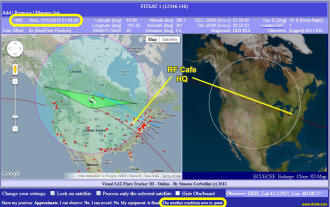FITSAT-1 CubeSat Flight over Erie, Pennsylvania - December 12, 2012
|
|
1 | 2 | 3 | 4 | 5 | 6 | 7 | 8 | 9 | 10 | 11 | 12 | 13 | 14 | 15 | 16 | 17 | 18 | 19 | 20 | 21 | 22 | 23 | 24 | 25 | 26 | 27 | 28 | 29 | 30 | 31 | 32 | 33 | 34 | 35 | 36 | 37  I stayed up late on the night of of
December 11, 2012 (early in the
morning, actually) to watch the FITSAT-1 CubeSat satellite flash its Morse code "HI DE NIWAKA JAPAN" message
via super-bright LEDs over eastern North America. It was scheduled to pass just
south of my location in Erie, Pennsylvania, at 1:14 AM, with a lights-on intensity
great enough to be easily seen with binoculars.
FITSAT-1 is
a project conceived of and built by professors and students at the Fukuoka Institute
of Technology (FIT) in Japan. In addition to the LED visual display, the satellite
also carries several Amateur Radio payloads including a CW beacon on 437.250 MHz,
a telemetry beacon on 437.445 MHz and a high-speed data downlink on 5,840.0 MHz. I stayed up late on the night of of
December 11, 2012 (early in the
morning, actually) to watch the FITSAT-1 CubeSat satellite flash its Morse code "HI DE NIWAKA JAPAN" message
via super-bright LEDs over eastern North America. It was scheduled to pass just
south of my location in Erie, Pennsylvania, at 1:14 AM, with a lights-on intensity
great enough to be easily seen with binoculars.
FITSAT-1 is
a project conceived of and built by professors and students at the Fukuoka Institute
of Technology (FIT) in Japan. In addition to the LED visual display, the satellite
also carries several Amateur Radio payloads including a CW beacon on 437.250 MHz,
a telemetry beacon on 437.445 MHz and a high-speed data downlink on 5,840.0 MHz.
The CubeSat Project was developed by California Polytechnic State University and Stanford University's Space Systems Development Lab. It creates launch opportunities for universities previously unable to access space. A CubeSat is 10 cm on a side and may have a mass of up to 1.33 kg. Launch vehicles sell space to CubeSats for around $40,000, which makes them very affordable to place in orbit. Kits of parts available from a number of suppliers range from around $6,000 for the frame and power supply to about $40,000 for an entire launchable platform. FITSAT-1 was launched from the International Space Station (ISS) at 15:44 (UTC) on October 4, 2012. Orbital tracking is provided in real time on the Visual SAT-Flare 3-D website. The screenshots below were obtained just one minute before I went outside to look for the satellite. As can be seen in the sky track map on the right (annotations added by me for identification), FITSAT-1 would pass directly through one of the most prominent objects in the winter sky: The Pleiades asterism in the constellation of Taurus (often mistaken for the Little Dipper). That would make the satellite easy to spot even for someone not familiar with the night sky. Amazingly, the path also crossed very close to the brightest star in Andromeda (Alpheratz), the brightest star in Taurus (Aldebaran), the 2nd brightest star in Orion (Betelgeuse), and midway between the brightest star in the entire northern hemisphere (Sirius in Canis Major) and the 7th brightest (Procyon in Canis Minor). The intensity of the LEDs would vary between about magnitude 7 (roughly the brightness of the dimmest of the six main stars in The Pleiades) and magnitude 12 (larger number is less bright). There is only one thing that could possibly keep a seasoned sky navigator like me from spotting FITSAT-1: clouds. Guess what? The sky had been mostly clear along the flight path up until around 10 PM. Accuweather predicted a further clearing through the night. By 1:10 AM, the entire sky was clouded over with only a rare opening. *@(#$*%^@!!!!! I grabbed the binoculars and frantically looked for a reference point. For a brief moment I found The Pleiades, but clouds quickly obscured them again. After all the planning I didn't get even a glimpse of FITSAT-1. When I got out of bed at 7:15 AM, there wasn't a cloud in the sky, from horizon to horizon! Life can suck sometimes. Hopefully, the tiny craft will still be in operation at a later date to give me a second chance at it. FITSAT-1 Earth and Sky Track Maps This video shows the building and launching processes for FITSAT-1
Posted August 15, 2022 |
 "
"
